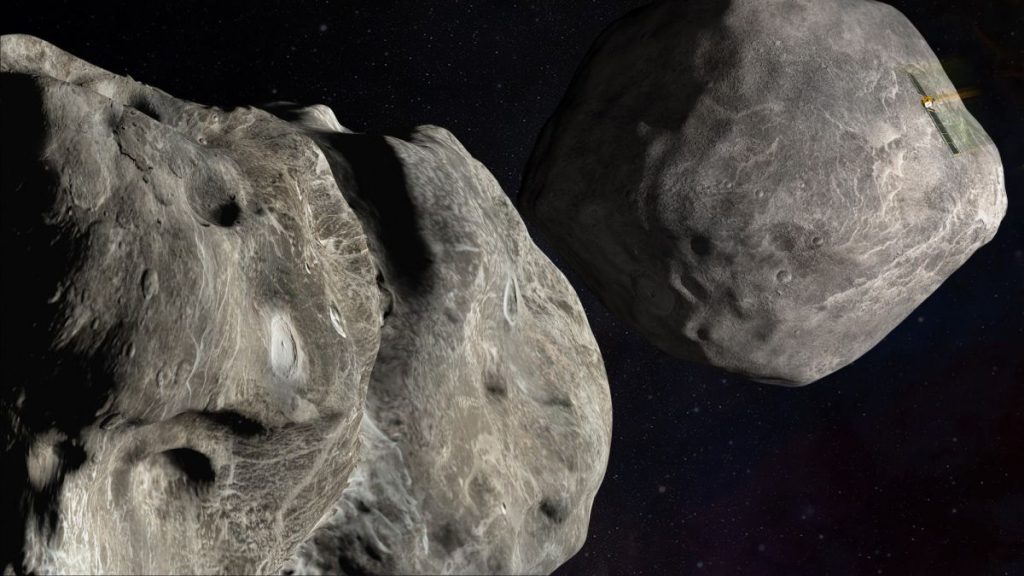
James Webb, Hubble space telescopes will try to watch DART asteroid impact (Image Credit: Space.com)
When NASA’s DART mission slams itself into an asteroid called Dimorphos next week, three different science spacecraft will be trying to watch the action.
The Double Asteroid Redirection Test (DART) mission is designed to test a planetary defense technique that could be put to use if humans discover a large asteroid on a collision course with Earth. The spacecraft carried with it a tiny cubesat to document its dramatic end, but three other eyes in the sky will also attempt to watch the impact: the James Webb and Hubble space telescopes and another NASA asteroid mission, Lucy.
“This is a unique opportunity and a unique moment to take all the resources that we possibly can to maximize what we’ve learned,” Nancy Chabot, a planetary scientist at Johns Hopkins University in Baltimore and the coordination lead for DART, said during a news conference held on Sept. 12.
Related: The greatest asteroid missions of all time!
DART launched in November 2021, bound for a binary asteroid system anchored by the larger Didymos, which a moonlet called Dimorphos orbits every 11 hours and 55 minutes. On Monday (Sept. 26), DART will test a technique called kinetic impact, a fancy term for slamming something large enough and fast enough into an asteroid to nudge its orbit.
Scientists want to observe a known impact event to understand how a future planetary defense mission might unfold, should humans want to deflect an asteroid headed toward colliding with Earth. (Neither Didymos nor Dimorphos poses an impact threat to Earth, and nothing that happens on Monday can change that, DART team members stress.)
Mission personnel hope to see images of the impact site just three minutes after launch, thanks to the tiny cubesat, LICIA Cube, that DART deployed earlier this month; the European Space Agency will also send a separate mission, Hera, to study the site in detail beginning in late 2026.
But a live view of the moment of impact itself from a telescope in space, unhindered by the blur of Earth’s atmosphere, would certainly be a nice bonus. So NASA will turn the veteran Hubble Space Telescope and the James Webb Space Telescope (JWST), which just began operations this summer, to try to catch DART’s impact, which will occur at 7:14 p.m. EDT (2314 GMT).
How good these space-based observations turn out to be is still unknown. “Let me just stress here, this is not what JWST is designed to do; this is a challenging measurement for them,” Chabot said. Dimorphos is much closer and moves much faster than the distant galaxies at the heart of JWST’s work. “They will be looking; we’ll see what they get.”
JWST faces a second challenge, which is that the telescope has to regularly check in on guide stars and readjust, which means its observations might begin a few minutes after impact, Tom Statler, DART program scientist, said during a news conference held Thursday (Sept. 22).
Hubble has its own constraints, since the telescope will be on the wrong side of Earth at the moment of impact, but it will begin observations about 15 minutes after impact. “Hubble won’t actually catch the exact moment of impact,” Statler said. “That’s OK because we don’t really expect anything to be really observable from the exact moment of impact.”
Along with the two space telescopes, NASA personnel have also arranged for instruments aboard the Lucy mission to observe the impact. Lucy launched in October 2021 to study asteroids that orbit the sun at the same distance as Jupiter and that scientists think hold clues about the earliest days of solar system history.
But for now, Lucy is still near Earth, since it must conduct a flyby next month to set its trajectory out to its targets, so it might be able to catch the impact. (Similarly, in May, the spacecraft took the opportunity to watch the moon disappear during a total lunar eclipse.) At the time of impact, Earth will be about 6.8 million miles (11 million kilometers) away from Didymos; Lucy will be about twice as far away and at a different viewing angle, Statler noted.
Although DART personnel only need to measure the change in Dimorphos’ orbit to determine whether the mission was a success, scientists are hoping to learn more about countless other characteristics of the moonlet, including its rotation and structure.
In addition to the immediate aftermath of the impact, the telescopes will also check up on Dimorphos occasionally until about the end of the year, Thomas said, augmenting continuing observations from the ground.
However the spacecraft observations fare, the rest of us will have to watch from the comfort of Earth. And there will be something to watch: NASA has set up a specific video feed that will livestream DART’s views of Dimorphos as it speeds to impact, with a new image sent each second until the spacecraft goes dark.
Email Meghan Bartels at mbartels@space.com or follow her on Twitter @meghanbartels. Follow us on Twitter @Spacedotcom and on Facebook.





